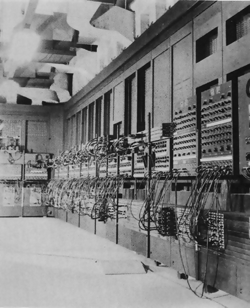ENIAC, short for Electronic Numerical Integrator And Computer, although earlier computers had been built with some of these properties. ENIAC was designed and built to calculate artillery firing tables for the U.S. Army's Ballistics Research Laboratory. The first problems run on the ENIAC however, were related to the design of the hydrogen bomb.
The contract was signed on June 5, 1943 and Project PX was constructed by the University of Pennsylvania's Moore School of Electrical Engineering from July, 1943. It was unveiled on February 14, 1946 at Penn, having cost almost $500,000. ENIAC was shut down on November 9, 1946 for a refurbishment and a memory upgrade, and was transferred to Aberdeen Proving Ground, Maryland in 1947. There, on July 29 of that year, it was turned on and would be in continuous operation until 11:45 p.m. on October 2, 1955.
ENIAC was conceived and designed by John Mauchly and J. Presper Eckert of the University of Pennsylvania. The team of design engineers assisting the development included Bob Shaw (function tables), Chuan Chu (divider/square-rooter), Kite Sharpless (master programmer), Arthur Burks (multiplier), Harry Huskey (reader/printer), and Jack Davis (accumulators).
Reliability
The six women who did most of the programming of ENIAC by manipulating its switches and cables were inducted in 1997 into the Women in Technology International Hall of Fame ([1]). As they were called by each other in 1946, they were Kay McNulty, Betty Jennings, Betty Snyder, Marlyn Wescoff, Fran Bilas and Ruth Lichterman.
Eckert and Mauchly took the experience they gained and founded the Eckert-Mauchly Computer Corporation, producing their first computer, BINAC, in 1949 before being acquired by Remington Rand in 1950 and renamed as their UNIVAC division.
ENIAC was a one-of-a-kind design and was never repeated. The freeze on design in 1943 meant that the computer had a number of shortcomings which were not solved, notably the inability to store a program. But the ideas generated from the work and the impact it had on people such as John von Neumann were profoundly influential in the development of later computers, initially EDVAC, EDSAC and SEAC.
A number of improvements were also made to ENIAC from 1948, including a primitive read-only stored programming mechanism [2] using the Function Tables as program ROM, an idea proposed by John von Neumann. Three digits of one accumulator (6) was used as the program counter, another accumulator (15) was used as the main accumulator, another accumulator (8) was used as the address pointer for reading data from the function tables, and most of the other accumulators (1-5,7,9-14,17-19) were just used for data memory. It was first demonstrated as a stored-program computer on September 16, 1948, running a program by Adele Goldstine for John von Neumann. This modification reduced the speed of ENIAC by a factor of six and eliminated the ability of parallel computation, but as it also reduced the reprogramming time to hours instead of days, it was considered well worth the loss of performance. Also analysis had shown that due to differences between the electronic speed of computation and the electromechanical speed of input/output, almost any practical real world problem was completely I/O bound even without making use of the original machine's parallelism and most would still be I/O bound even after the speed reduction from this modification. Early in 1952, a high speed shifter was added, which improved the speed for shifting by a factor of five. In July 1953, a 100-word expansion core memory was added to the system, using binary coded decimal, excess-3 number representation. To support this expansion memory, the ENIAC was equipped with a new Function Table selector, a memory address selector, pulse-shaping circuits, and three new orders were added to the programming mechanism.
 Programmability
Programmability
1 comment:
酒店經紀菲梵,酒店經紀~free fun~,酒店經紀,酒店經紀,酒店上班,酒店上班,酒店小姐,酒店小姐,酒店工作,酒店工作,酒店打工,酒店打工,酒店兼差,酒店兼差,酒店兼職,酒店兼職,經紀人,經紀人,禮服店,禮服店,便服店,便服店,
Post a Comment